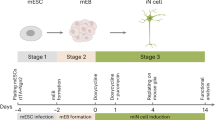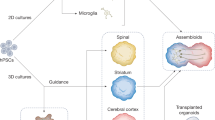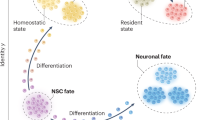Abstract
Listen to an interview with Fred Gage on the stem cells podcast
The production of specialized differentiated neurons derived from stem cells has been proposed as a revolutionary technology for regenerative medicine. However, few examples of specific neuronal cell differentiation have been described so far. Although stem-cell tissue replacement might be seemingly straightforward in other cases, the high degree of complexity of the nervous system raises the challenge of tissue replacement substantially. Understanding mechanisms of neuronal diversification will not only be relevant for therapeutic purposes but might also shed light on the differences in cognitive abilities, personality traits and psychiatric conditions observed in humans.
This is a preview of subscription content, access via your institution
Access options
Subscribe to this journal
Receive 51 print issues and online access
$199.00 per year
only $3.90 per issue
Buy this article
- Purchase on Springer Link
- Instant access to full article PDF
Prices may be subject to local taxes which are calculated during checkout





Similar content being viewed by others
References
Koch, C. & Laurent, G. Complexity and the nervous system. Science 284, 96–98 (1999).
Vogel, E. K. & Machizawa, M. G. Neural activity predicts individual differences in visual working memory capacity. Nature 428, 748–751 (2004).
Williams, R. W. Mapping genes that modulate mouse brain development: a quantitative genetic approach. Results Probl. Cell Differ. 30, 21–49 (2000).
Pakkenberg, B. et al. Aging and the human neocortex. Exp. Gerontol. 38, 95–99 (2003).
Angevine, J. B. Jr. Time of neuron origin in the diencephalon of the mouse. An autoradiographic study. J. Comp. Neurol. 139, 129–187 (1970).
Finlay, B. L. & Slattery, M. Local differences in the amount of early cell death in neocortex predict adult local specializations. Science 219, 1349–1351 (1983).
Ferrer, I., Soriano, E., del Rio, J. A., Alcantara, S. & Auladell, C. Cell death and removal in the cerebral cortex during development. Prog. Neurobiol. 39, 1–43 (1992).
Oppenheim, R. W. Cell death during development of the nervous system. Annu. Rev. Neurosci. 14, 453–501 (1991).
Lie, D. C., Song, H., Colamarino, S. A., Ming, G. L. & Gage, F. H. Neurogenesis in the adult brain: new strategies for central nervous system diseases. Annu. Rev. Pharmacol. Toxicol. 44, 399–421 (2004).
Taupin, P. & Gage, F. H. Adult neurogenesis and neural stem cells of the central nervous system in mammals. J. Neurosci. Res. 69, 745–749 (2002).
Gage, F. H. Mammalian neural stem cells. Science 287, 1433–1438 (2000).
Jones, J. M. & Gellert, M. The taming of a transposon: V(D)J recombination and the immune system. Immunol. Rev. 200, 233–248 (2004).
Gotz, M. & Sommer, L. Cortical development: the art of generating cell diversity. Development 132, 3327–3332 (2005).
Burgess, N. & O'Keefe, J. Neural representations in human spatial memory. Trends Cogn. Sci. 7, 517–519 (2003).
Gao, Y. et al. A critical role for DNA end-joining proteins in both lymphogenesis and neurogenesis. Cell 95, 891–902 (1998).
Matsuoka, M. et al. Detection of somatic DNA recombination in the transgenic mouse brain. Science 254, 81–86 (1991).
Abeliovich, A. et al. On somatic recombination in the central nervous system of transgenic mice. Science 257, 404–410 (1992).
Eggan, K. et al. Mice cloned from olfactory sensory neurons. Nature 428, 44–49 (2004).
Li, J., Ishii, T., Feinstein, P. & Mombaerts, P. Odorant receptor gene choice is reset by nuclear transfer from mouse olfactory sensory neurons. Nature 428, 393–399 (2004).
Ogasawara, M., Aoki, K., Okada, S. & Suzumori, K. Embryonic karyotype of abortuses in relation to the number of previous miscarriages. Fertil. Steril. 73, 300–304 (2000).
Pathak, S. & Multani, A. S. Aneuploidy, stem cells and cancer. EXS 2006, 49–64 (2006).
Palmer, T. D., Takahashi, J. & Gage, F. H. The adult rat hippocampus contains primordial neural stem cells. Mol. Cell. Neurosci. 8, 389–404 (1997).
Rehen, S. K. et al. Chromosomal variation in neurons of the developing and adult mammalian nervous system. Proc. Natl Acad. Sci. USA 98, 13361–13366 (2001).
Rehen, S. K. et al. Constitutional aneuploidy in the normal human brain. J. Neurosci. 25, 2176–2180 (2005).
Fuller, C. E. & Perry, A. Fluorescence in situ hybridization (FISH) in diagnostic and investigative neuropathology. Brain Pathol. 12, 67–86 (2002).
Kingsbury, M. A. et al. Aneuploid neurons are functionally active and integrated into brain circuitry. Proc. Natl Acad. Sci. USA 102, 6143–6147 (2005).
Gaudet, J. & Mango, S. E. Regulation of organogenesis by the Caenorhabditis elegans FoxA protein PHA-4. Science 295, 821–825 (2002).
Yang, A. H. et al. Chromosome segregation defects contribute to aneuploidy in normal neural progenitor cells. J. Neurosci. 23, 10454–10462 (2003).
Muotri, A. R. et al. Somatic mosaicism in neuronal precursor cells mediated by L1 retrotransposition. Nature 435, 903–910 (2005).
Lander, E. S. et al. Initial sequencing and analysis of the human genome. Nature 409, 860–921 (2001).
Gibbs, R. A. et al. Genome sequence of the Brown Norway rat yields insights into mammalian evolution. Nature 428, 493–521 (2004).
Waterston, R. H. et al. Initial sequencing and comparative analysis of the mouse genome. Nature 420, 520–562 (2002).
Wei, W. et al. Human L1 retrotransposition: cis preference versus trans complementation. Mol. Cell. Biol. 21, 1429–1439 (2001).
Esnault, C., Maestre, J. & Heidmann, T. Human LINE retrotransposons generate processed pseudogenes. Nature Genet. 24, 363–367 (2000).
Dewannieux, M., Esnault, C. & Heidmann, T. LINE-mediated retrotransposition of marked Alu sequences. Nature Genet. 35, 41–48 (2003).
Kajikawa, M. & Okada, N. LINEs mobilize SINEs in the eel through a shared 3′ sequence. Cell 111, 433–444 (2002).
Gilbert, N., Lutz, S., Morrish, T. A. & Moran, J. V. Multiple fates of L1 retrotransposition intermediates in cultured human cells. Mol. Cell. Biol. 25, 7780–7795 (2005).
Kazazian, H. H. Jr. Mobile elements: drivers of genome evolution. Science 303, 1626–1632 (2004).
Smale, S. T. & Kadonaga, J. T. The RNA polymerase II core promoter. Annu. Rev. Biochem. 72, 449–479 (2003).
Ayoubi, T. A. & Van De Ven, W. J. Regulation of gene expression by alternative promoters. FASEB J. 10, 453–460 (1996).
Myers, S. J., Dingledine, R. & Borges, K. Genetic regulation of glutamate receptor ion channels. Annu. Rev. Pharmacol. Toxicol. 39, 221–241 (1999).
Tabuchi, A. et al. Differential activation of brain-derived neurotrophic factor gene promoters I and III by Ca2+ signals evoked via L-type voltage-dependent and N-methyl-D-aspartate receptor Ca2+ channels. J. Biol. Chem. 275, 17269–17275 (2000).
Liu, Q. R. et al. Rodent BDNF genes, novel promoters, novel splice variants, and regulation by cocaine. Brain Res. 1067, 1–12 (2006).
Metsis, M., Timmusk, T., Arenas, E. & Persson, H. Differential usage of multiple brain-derived neurotrophic factor promoters in the rat brain following neuronal activation. Proc. Natl Acad. Sci. USA 90, 8802–8806 (1993).
Maniatis, T. & Tasic, B. Alternative pre-mRNA splicing and proteome expansion in metazoans. Nature 418, 236–243 (2002).
Yeo, G., Holste, D., Kreiman, G. & Burge, C. B. Variation in alternative splicing across human tissues. Genome Biol. 5, R74 (2004).
Grabowski, P. J. & Black, D. L. Alternative RNA splicing in the nervous system. Prog. Neurobiol. 65, 289–308 (2001).
Dredge, B. K., Polydorides, A. D. & Darnell, R. B. The splice of life: alternative splicing and neurological disease. Nature Rev. Neurosci. 2, 43–50 (2001).
Schmucker, D. et al. Drosophila Dscam is an axon guidance receptor exhibiting extraordinary molecular diversity. Cell 101, 671–684 (2000).
Missler, M. & Sudhof, T. C. Neurexins: three genes and 1001 products. Trends Genet. 14, 20–26 (1998).
Wu, Q. & Maniatis, T. A striking organization of a large family of human neural cadherin-like cell adhesion genes. Cell 97, 779–790 (1999).
Tasic, B. et al. Promoter choice determines splice site selection in protocadherin α and γ pre-mRNA splicing. Mol. Cell 10, 21–33 (2002).
Daoud, R., Da Penha Berzaghi, M., Siedler, F., Hubener, M. & Stamm, S. Activity-dependent regulation of alternative splicing patterns in the rat brain. Eur. J. Neurosci. 11, 788–802 (1999).
Vezzani, A., Speciale, C., Della Vedova, F., Tamburin, M. & Benatti, L. Alternative splicing at the C-terminal but not at the N-terminal domain of the NMDA receptor NR1 is altered in the kindled hippocampus. Eur. J. Neurosci. 7, 2513–2517 (1995).
Wang, Z. & Grabowski, P. J. Cell- and stage-specific splicing events resolved in specialized neurons of the rat cerebellum. RNA 2, 1241–1253 (1996).
Black, D. L. Mechanisms of alternative pre-messenger RNA splicing. Annu. Rev. Biochem. 72, 291–336 (2003).
Young, J. I. et al. Regulation of RNA splicing by the methylation-dependent transcriptional repressor methyl-CpG binding protein 2. Proc. Natl Acad. Sci. USA 102, 17551–17558 (2005).
Edwalds-Gilbert, G., Veraldi, K. L. & Milcarek, C. Alternative poly(A) site selection in complex transcription units: means to an end? Nucleic Acids Res. 25, 2547–2561 (1997).
Balmer, D., Goldstine, J., Rao, Y. M. & LaSalle, J. M. Elevated methyl-CpG-binding protein 2 expression is acquired during postnatal human brain development and is correlated with alternative polyadenylation. J. Mol. Med. 81, 61–68 (2003).
Pelka, G. J., Watson, C. M., Christodoulou, J. & Tam, P. P. Distinct expression profiles of Mecp2 transcripts with different lengths of 3′UTR in the brain and visceral organs during mouse development. Genomics 85, 441–452 (2005).
Zhang, H., Lee, J. Y. & Tian, B. Biased alternative polyadenylation in human tissues. Genome Biol. 6, R100 (2005).
de Moor, C. H., Meijer, H. & Lissenden, S. Mechanisms of translational control by the 3′ UTR in development and differentiation. Semin. Cell Dev. Biol. 16, 49–58 (2005).
Keegan, L. P., Gallo, A. & O'Connell, M. A. The many roles of an RNA editor. Nature Rev. Genet. 2, 869–878 (2001).
Paul, M. S. & Bass, B. L. Inosine exists in mRNA at tissue-specific levels and is most abundant in brain mRNA. EMBO J. 17, 1120–1127 (1998).
Tonkin, L. A. et al. RNA editing by ADARs is important for normal behavior in Caenorhabditis elegans. EMBO J. 21, 6025–6035 (2002).
Palladino, M. J., Keegan, L. P., O'Connell, M. A. & Reenan, R. A. A-to-I pre-mRNA editing in Drosophila is primarily involved in adult nervous system function and integrity. Cell 102, 437–449 (2000).
Keegan, L. P., Gallo, A. & O'Connell, M. A. Development. Survival is impossible without an editor. Science 290, 1707–1709 (2000).
Dingledine, R., Borges, K., Bowie, D. & Traynelis, S. F. The glutamate receptor ion channels. Pharmacol. Rev. 51, 7–61 (1999).
Vissel, B. et al. The role of RNA editing of kainate receptors in synaptic plasticity and seizures. Neuron 29, 217–227 (2001).
Kwak, S. & Kawahara, Y. Deficient RNA editing of GluR2 and neuronal death in amyotropic lateral sclerosis. J. Mol. Med. 83, 110–120 (2005).
Niswender, C. M., Copeland, S. C., Herrick-Davis, K., Emeson, R. B. & Sanders-Bush, E. RNA editing of the human serotonin 5-hydroxytryptamine 2C receptor silences constitutive activity. J. Biol. Chem. 274, 9472–9478 (1999).
Niswender, C. M. et al. RNA editing of the human serotonin 5-HT2C receptor: alterations in suicide and implications for serotonergic pharmacotherapy. Neuropsychopharmacology 24, 478–491 (2001).
Akbarian, S., Smith, M. A. & Jones, E. G. Editing for an AMPA receptor subunit RNA in prefrontal cortex and striatum in Alzheimer's disease, Huntington's disease and schizophrenia. Brain Res. 699, 297–304 (1995).
Gurevich, I. et al. Altered editing of serotonin 2C receptor pre-mRNA in the prefrontal cortex of depressed suicide victims. Neuron 34, 349–356 (2002).
Grant, S. G. The synapse proteome and phosphoproteome: a new paradigm for synapse biology. Biochem. Soc. Trans. 34, 59–63 (2006).
Flavell, S. W. et al. Activity-dependent regulation of MEF2 transcription factors suppresses excitatory synapse number. Science 311, 1008–1012 (2006).
Shalizi, A. et al. A calcium-regulated MEF2 sumoylation switch controls postsynaptic differentiation. Science 311, 1012–1017 (2006).
Gottesman, I. I. & Hanson, D. R. Human development: biological and genetic processes. Annu. Rev. Psychol. 56, 263–286 (2005).
Branchi, I., Francia, N. & Alleva, E. Epigenetic control of neurobehavioural plasticity: the role of neurotrophins. Behav. Pharmacol. 15, 353–362 (2004).
Sims, R. J., Nishioka, K. & Reinberg, D. Histone lysine methylation: a signature for chromatin function. Trends Genet. 19, 629–639 (2003).
Stadler, F. et al. Histone methylation at gene promoters is associated with developmental regulation and region-specific expression of ionotropic and metabotropic glutamate receptors in human brain. J. Neurochem. 94, 324–336 (2005).
Karlsson, H. et al. Retroviral RNA identified in the cerebrospinal fluids and brains of individuals with schizophrenia. Proc. Natl Acad. Sci. USA 98, 4634–4639 (2001).
Yee, F. & Yolken, R. H. Identification of differentially expressed RNA transcripts in neuropsychiatric disorders. Biol. Psychiatry 41, 759–761 (1997).
Kim, H. S., Takenaka, O. & Crow, T. J. Isolation and phylogeny of endogenous retrovirus sequences belonging to the HERV-W family in primates. J. Gen. Virol. 80, 2613–2619 (1999).
Frank, O. et al. Human endogenous retrovirus expression profiles in samples from brains of patients with schizophrenia and bipolar disorders. J. Virol. 79, 10890–10901 (2005).
Yolken, R. H., Karlsson, H., Yee, F., Johnston-Wilson, N. L. & Torrey, E. F. Endogenous retroviruses and schizophrenia. Brain Res. Brain Res. Rev. 31, 193–199 (2000).
Kan, P. X., Popendikyte, V., Kaminsky, Z. A., Yolken, R. H. & Petronis, A. Epigenetic studies of genomic retroelements in major psychosis. Schizophr. Res. 67, 95–106 (2004).
Cao, X., Yeo, G., Muotri, A. R., Kuwabara, T. & Gage, F. H. Noncoding RNAs in the mammalian central nervous system. Annu. Rev. Neurosci. Published online 15 Mar 2006 (doi:10.1146/annurev.neuro.29.051605.112839).
Kosik, K. S. & Krichevsky, A. M. The elegance of the microRNAs: a neuronal perspective. Neuron 47, 779–782 (2005).
Pasquinelli, A. E., Hunter, S. & Bracht, J. MicroRNAs: a developing story. Curr. Opin. Genet. Dev. 15, 200–205 (2005).
Bartel, D. P. MicroRNAs: genomics, biogenesis, mechanism, and function. Cell 116, 281–297 (2004).
Kuwabara, T., Hsieh, J., Nakashima, K., Taira, K. & Gage, F. H. A small modulatory dsRNA specifies the fate of adult neural stem cells. Cell 116, 779–793 (2004).
Belancio, V. P., Hedges, D. J. & Deininger, P. LINE-1 RNA splicing and influences on mammalian gene expression. Nucleic Acids Res. 34, 1512–1521 (2006).
Roy-Engel, A. M. et al. Human retroelements may introduce intragenic polyadenylation signals. Cytogenet. Genome Res. 110, 365–371 (2005).
Meischl, C., Boer, M., Ahlin, A. & Roos, D. A new exon created by intronic insertion of a rearranged LINE-1 element as the cause of chronic granulomatous disease. Eur. J. Hum. Genet. 8, 697–703 (2000).
Francesconi, A. & Duvoisin, R. M. Alternative splicing unmasks dendritic and axonal targeting signals in metabotropic glutamate receptor 1. J. Neurosci. 22, 2196–2205 (2002).
Acknowledgements
A.R.M. is a Pew Latin American Fellow. F.H.G. was supported by the Lookout Fund, and the National Institutes of Health National Institute on Aging and National Institute of Neurological Disorders and Stroke. The authors would like to thank M. L. Gage for editorial comments, and N. Spitzer and members of the Gage laboratory for critical comments on the manuscript. We regret that, owing to space limitations, we have been unable to refer to all of the primary literature and have had to rely instead, in many instances, on reviews.
Author information
Authors and Affiliations
Corresponding author
Ethics declarations
Competing interests
The authors declare no competing financial interests.
Additional information
Reprints and permissions information is available at npg.nature.com/reprintsandpermissions.
Rights and permissions
About this article
Cite this article
Muotri, A., Gage, F. Generation of neuronal variability and complexity. Nature 441, 1087–1093 (2006). https://doi.org/10.1038/nature04959
Published:
Issue Date:
DOI: https://doi.org/10.1038/nature04959
This article is cited by
-
Somatic mosaicism in the diseased brain
Molecular Cytogenetics (2022)
-
Impact of Multidomain Lifestyle Intervention on Cerebral Cortical Thickness and Serum Brain-Derived Neurotrophic Factor: the SUPERBRAIN Exploratory Sub-study
Neurotherapeutics (2022)
-
A retrotransposon storm marks clinical phenoconversion to late-onset Alzheimer’s disease
GeroScience (2022)
-
Somatic mutations in neurons during aging and neurodegeneration
Acta Neuropathologica (2018)
-
Human Molecular Neurocytogenetics
Current Genetic Medicine Reports (2018)
Comments
By submitting a comment you agree to abide by our Terms and Community Guidelines. If you find something abusive or that does not comply with our terms or guidelines please flag it as inappropriate.



